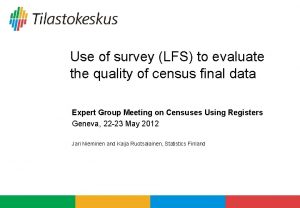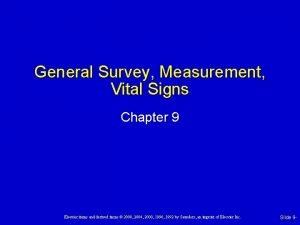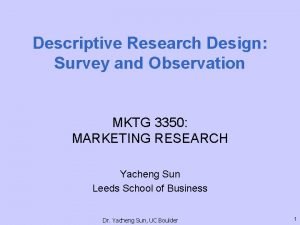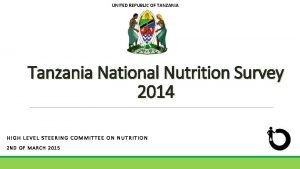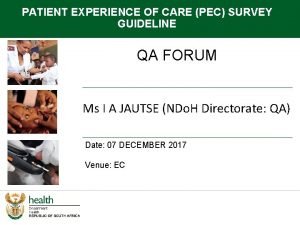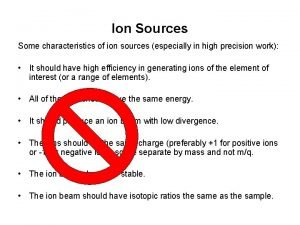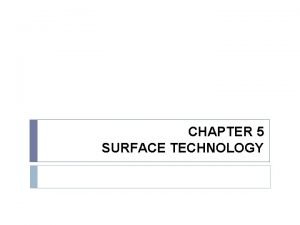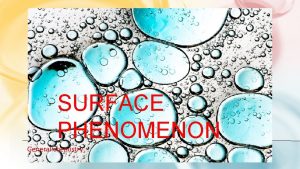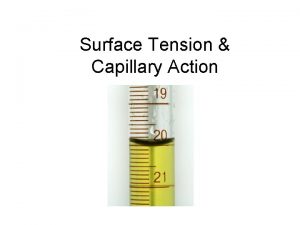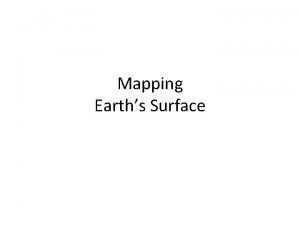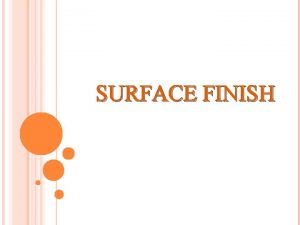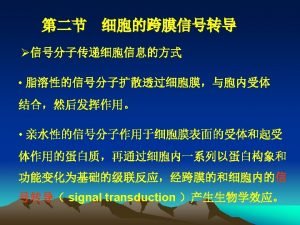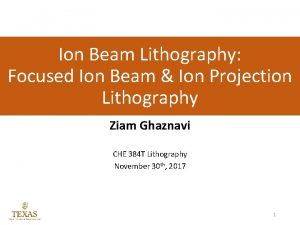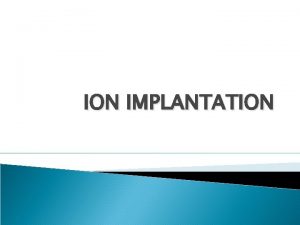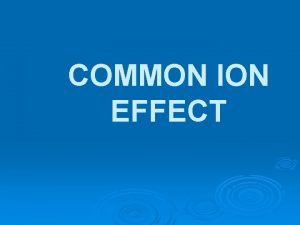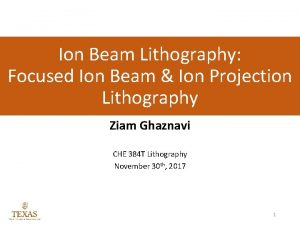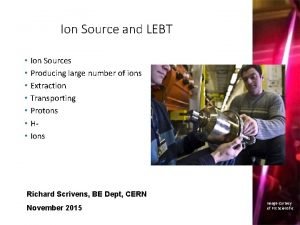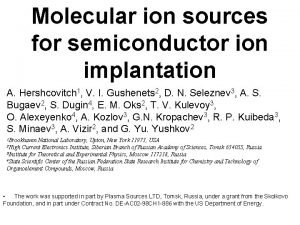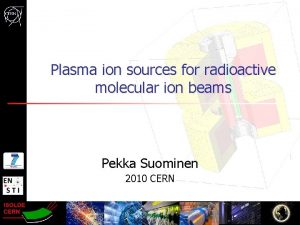Survey of ion sources H ion sources Surface



















- Slides: 19

Survey of ion sources

• H+ ion sources • Surface plasma H- production • Volume H- production • H- ion source types

There are basically 2 styles of H+ sources that are used in most labs Electron Cyclotron Resonance (ECR) ESS, SPIRAL 2, FAIR Duoplasmatron INR RAS, FNAL HINS,

H+ sources Duoplasmatrons Low plasma density region H+ Filament (cathode) H 2 High plasma density region • A cathode is heated, giving off electrons they are attracted to the “intermediate electrode”. As they travel towards the electrode they collide with the surrounding gas (H 2 in this case) • These collisions free additional electrons which collide with other particles • The intermediate electrode squeezes down the electrons giving a dense plasma • Low density plasma in the chamber/high density plasma outside the chamber gives the name duo-plasmatron • The high negative potential on the anode pulls H+ out of the source

Microwave ECR sources 2. 45 GHz microwaves , which correspond to the electron cyclotron frequency are injected into the source volume which ionizes a low pressure gas into a plasma.

H+ sources Source type Beam current Pulse width Rep rate FAIR ECR 70 m. A 4 Hz PEFP Duoplasmatron 20 m. A 2 ms 120 Hz ESS ECR 60 m. A 2 ms 20 Hz SPIRAL 2 ECR 5 m. A DC 140 m. A DC IFMIF INR RAS Duoplasmatron 50 -120 m. A 200 us 50 Hz

Surface production Sources (SPS) e- Mo Cathode (-) Cs H+H 2+ ~1 mm Figure from Stockli USPAS June 2007 H- • Mo has a host of loosely bound e- that take about 4. 6 e. V to remove • Cs lowers the surface work function to about 1. 8 e. V with 0. 6 mono-layer thickness • Hydrogen affinity is about 0. 75 e. V so most of the hydrogen particle leave the surface as neutrals, however a few leave the surface as Hions • This is why we use cesiated sources e. Anode (+) B e- Cs Cs Cs P H H Figure from ZHANG Ion Sources Figure from Stockli USPAS June 2007

Volume H- production For volume sources, H- ion production relies on increased cross section for dissociative-attachment reaction (in the plasma volume) when molecules are excited to high vibrational states (v”>2). Primary ionization chamber H- formation region e- (cold) e- (hot) e. H- H 2(n>0) ions H H 2(n=0) H 2(n>0) e- (hot) Figure from Stockli USPAS June 2007 Filter B-field

There are basically 5 proven H- ion sources in use at major labs: Surface conversion (LANL, KEK) Penning (RAL, INR) Magnetron (FNAL, BNL, ANL, DESY) Filament-driven volume (TRIUMF, Jyväskylä) RF-driven volume (DESY, SNS)

magnetron cathode Magnetron sources FNAL magnetron H- sources are used • In Cockcroft-Walton • New source for Preinjector upgrade (RFQ project) N H- 6 cm S Plasma is generated by Ex. B motion of electrons • H- are produced at the cathode surface then extracted (SPS Source) • They are then pulled out of the source by the extractor H- e-

Magnetron sources FNAL BNL Parameter Value H- beam current 50 - 60 m. A H- beam current 100 m. A Arc current 45 - 55 A Arc current 10 A Arc Voltage 115 – 145 V Arc Voltage 150 V Extractor Voltage 15 – 18 k. V Extractor Voltage 35 k. V Pulse width 80 usec Pulse width 700 usec Rep Rate 15 Hz Rep Rate 7. 5 Hz Duty factor 0. 12% Duty factor 0. 5% Power efficiency 9 m. A/k. W Power efficiency 67 m. A/k. W ! Average lifetime 3. 5 months Average lifetime 9 months

Penning sources Cs Anode (+) e. H+ B Mo H-(fast) B H (chr. ex. ) Cathode (-) Extractor e- Anode (+) H- Cathode (-) Figure from Stockli USPAS June 2007 H-(fast)+H(slow) H(fast)+H-(slow) • H- ions produced on the cathode similar to magnetron • Relies on charge exchange to produce slow H- ions for extraction • One benefit: easy access to cathode allows cooling which in turn allows higher duty factors (possibly DC)

Penning sources RAL ISIS penning source Dan Faircloth 2012 Parameter Value H- beam current 70 m. A Arc current 50 A Extractor Voltage 17 k. V Pulse width 2 msec Rep Rate 50 Hz Duty factor 10% Average lifetime 20 days Dan Faircloth 2012

Mulit- cusp converter ion source Multicusp magnets Cs Cathode (-) Anode (+) H+ HConverter (H- production surface) Multicusp B field Figure from Stockli USPAS June 2007 • Large volume, low pressure plasma • Cusp field minimizes electron loss to walls/confines plasma to center or source • H+ ions created in plasma strike converter plate to produce H- ions

Mulit- cusp converter ion source Parameter Value H- beam current 20 m. A Arc current 60 A Arc Voltage 100 V Extractor Voltage 80 k. V Pulse width 1 msec Rep Rate 120 Hz Duty factor 12% Average lifetime 4 weeks Power efficiency 3 m. A/k. W

Filament driven volume source e- (hot) Filter magnets H 2(n>0) H 2(n=0) e- (hot) H 2(n>0) ions efilament H- e- (cold) 26 cm Figure from Stockli USPAS June 2007 • Filaments biased to create electrons with sufficient energy to excite hydrogen to high vibrational states • Small volume area separated from larger volume by magnetic field to stop energetic e- from destroying the H- ions once they are produced • Typically low current sources, but high duty factors (DC)

Filament driven volume source Company called D-Pace manufactures filament driven volume sources ranging from 5 m. A to 15 m. A Parameter Value H- beam current 15 m. A Arc current 45 A Arc Voltage 150 V Extractor Voltage 20 – 30 k. V Rep Rate DC Duty factor Average lifetime - 350 hrs

RF driven volume source BRF(2 MHz) ions ERF(2 MHz) RF antenna SNS multicusp RF ion source and LEBT Filler magnet region Parameter Value H- beam current 67 m. A Pulse Width 1. 23 ms Beam Energy 65 ke. V Rep Rate 60 Hz Duty factor 100% Average lifetime ~11 weeks

H- ion source parameters for different types of sources Facility Source type LEBT type Cs Curr- Pulse ent length (m. A) (ms) DESY Multicusp 2 30 No 0. 15 (RF) ext. RF solenoids 40 Fermi magnetron Dipole Yes ~60 0. 1 BNL 2 magnetron Yes ~100 0. 6 solenoids ISIS ~60 Penning Dipole Yes 0. 5 ~35 LANSCE Surface 2 ~18 Yes 1 converter solenoids {40} J-PARC Multicusp 2 20 No 0. 5 La. B 6 filam. solenoids 35 SNS Multicusp 2 Einzel ~20 Yes <1 Frontend int. RF lenses 41 SNS Multicusp 2 Einzel 33 Yes 1. 23 Teststand int. RF lenses 41 JAERI Multicusp 60 NA Yes 1 W-filament 72 Sumy Inverse NA No ~50 0. 1 -1 magnetron Rep Extrac Normalized Rate Aperat Emittance (rms) (Hz) (mm) 0. 26 (90%) 8 6. 5 0. 43 (90%) 15 0. 9 x 10 0. 2/0. 3 6. 66 2 ~0. 4 10 ~1 50 0. 6 x 10 ~0. 15/0. 29 10 ~0. 14 (98%) 120 {8} {~0. 3 (98%)} 0. 15/0. 18 (9? %) 25 9 0. 12/0. 14 (100%) 1 -5 7 0. 25/0. 31 (100%) 60 0. 18/0. 26 (100%) 7 10 0. 25/0. 31 (100%) ~0. 21 (100%) 50 8 1 -10 5. 4 - Emittance Location Life- Energy time (ke. V) (weeks) LEBT >150 38 750 ke. V ~30 ~20 LEBT ~30 35 Dipole exit 665 ke. V ~3 35 LEBT >4 - 80 LEBT >3 50 Test LEBT exit >11 2. 3 - Source exit ~0. 5 - 65 65 70 <106 p 10 -100 Figure from Stockli USPAS June 2007
 Abcd of acls
Abcd of acls Fuerzas dipolo dipolo ejemplos
Fuerzas dipolo dipolo ejemplos Que son fuerzas intramoleculares
Que son fuerzas intramoleculares London forces vs van der waals
London forces vs van der waals C6h12 fuerza intermolecular
C6h12 fuerza intermolecular Importance of water
Importance of water Print and web sources
Print and web sources Volume and surface area of cone
Volume and surface area of cone Lateral area.
Lateral area. High surface tension vs low surface tension
High surface tension vs low surface tension Contoh survey monkey
Contoh survey monkey Labour force survey
Labour force survey General
General Advantages of descriptive research
Advantages of descriptive research Asdc survey co
Asdc survey co Tanzania national nutrition survey 2018
Tanzania national nutrition survey 2018 Characteristics of survey research
Characteristics of survey research Jda salary survey
Jda salary survey Survey solutions interviewer app
Survey solutions interviewer app Pec survey
Pec survey











